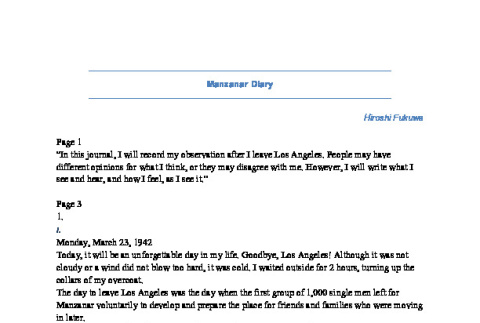Work and jobs
Both Issei and Nisei took jobs within the camps, at wages set not to exceed soldiers' pay: $12 per month for unskilled labor, $16 for skilled labor, and $19 for professional employees. WRA staff was paid much more for the same jobs. Though public opinion mandated such low pay, dissatisfied Japanese Americans objected to losing their right to make a decent living. They had to use their sparse income for necessities, such as warm clothing and shoes.
World War II
(231)
Concentration camps
(1454)
Work and jobs
(1374)
Related articles from the
Densho Encyclopedia :
Amache Silk Screen Shop
1374 items
1374 items

img
Jimmy Yokota (ddr-csujad-38-284)
Photographed is Jimmy Yokota, an incarceree at the Jerome camp in Arkansas, working on a utility pole. The photo was sent from Sally Sakaye Sasaki at the Jerome camp to Mitzi Masukawa Naohara at the Poston camp in Arizona. The caption reads: Jimmy Yokota. Title from caption. A photo from: Mitzi Naohara photo album (csudh_nao_0200), page …

doc
Identification and work history card (ddr-csujad-38-549)
An identification and work history card issued for George Nobuo Naohara, an incarceree at the Manzanar camp in California. See this object in the California State Universities Japanese American Digitization project site: nao_05_13_001

img
Women in apron (ddr-csujad-37-6)
Photograph of two women in apron standing in front of a barrack at the Heart Mountain incarceration camp. See this object in the California State Universities Japanese American Digitization project site: mhf_006

doc
Where old soles are traded for new (ddr-csujad-38-346)
A newspaper clipping titled, "Where old soles are traded for new," published in "Denson tribune" on June 11, 1943. It describes incarcerees who work in the shoe repair shop at the Jerome camp in Arkansas. The clipping was sent from Mitzi Masukawa Naohara's friend, "Sock," at the Jerome camp to Mitzi at the Poston camp in …
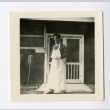
img
George Naohara (ddr-csujad-38-93)
George Nobuo Naohara is photographed wearing an apron outside the entrance to a mess hall, "Dining," at the Jerome incarceration camp in Arkansas. A photo from "George Naohara photo album" (csudh_nao_0001), page 21. See this object in the California State Universities Japanese American Digitization project site: nao_01_21_008

img
Atsushi Art Ishida with tractor (ddr-csujad-38-99)
Photographed is Atsushi Art Ishida posing in front of a tractor in the Jerome incarceration camp in Arkansas. Autographed by Atsushi Art Ishida. A photo from "George Naohara photo album" (csudh_nao_0001), page 22. See this object in the California State Universities Japanese American Digitization project site: nao_01_22_004

img
Lumbering (ddr-csujad-38-282)
Photographed are two male incarcerees lumbering. The photo was sent from Sally Sakaye Sasaki at the Jerome camp to Mitzi Masukawa Naohara at the Poston camp in Arizona. The handwritten note on the back side reads: The tree survived for 50 years and did not expect to be cut down by us. Two people cut the …
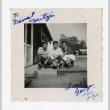
img
George Naohara and Atsushi Art Ishida in the Jerome camp (ddr-csujad-38-252)
Photographed are George Nobuo Naohara and Atsushi Art Ishida at the Jerome camp in Arkansas. George is wearing an apron. The photo was given to Mitzi Masukawa Naohara incarcerated in the Poston camp in Arizona. A photo from: Mitzi Naohara photo album (csudh_nao_0200), page 13. See this object in the California State Universities Japanese American Digitization …

img
Farm workers (ddr-csujad-26-139)
Photo of farm workers appearing to harvest a crop. From photo album of Robert Billigmeier. See this object in the California State Universities Japanese American Digitization project site: mei_05_109

doc
Personality cards (ddr-csujad-26-44)
Journal entries written by high school students discussing their observations and perspectives on a variety of topics including social and cultural differences, personality conflicts, friendships, social interactions, school, dogs, memories, reflections on camp life, weather, a friend in the military visiting his parents in camp, hobbies, and opinions about other people and daily life. Each entry …
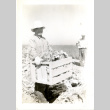
img
Man with crate of produce (ddr-csujad-26-95)
A farmer poses with a full crate of produce. From photo album of Robert Billigmeier. See this object in the California State Universities Japanese American Digitization project site: mei_05_032

doc
Messhalls in Tule Lake (ddr-csujad-26-23)
Report describing the mess halls of Tule Lake including: administrative organization, operations, personnel, duties, conflicts, wages, food procurement and distribution, food preparation, schedules, sample menus, dietary accommodations, food rationing and shortages, seating capacity, seating arrangements and systems, utensils, and incarceree attendance. The report analyzes workers and incarceree behaviors, status, mental faculties, disposition, religion, age, and gender. …

img
Young man on tractor (ddr-csujad-26-131)
Photo of a young Japanese American man on a tractor. Barracks building are seen in the background. From photo album of Robert Billigmeier. See this object in the California State Universities Japanese American Digitization project site: mei_05_101
![Procurement and Shoe Rationing [Department] (ddr-csujad-26-106)](https://ddr.densho.org/media/cache/55/fa/55fa2cde6e1970231d2a24d835ef95fe.jpg)
img
Procurement and Shoe Rationing [Department] (ddr-csujad-26-106)
Letter from David O'Kane describing provenance and donating the included photo of the Procurement an Shoe Rationing Department at Tule Lake camp to Special Collections at Cal State Hayward. The photo features a group of five Japanese American women with five Caucasian men and women. The verso of the photo reads, "This was taken just before …

doc
Tule Lake monograph (ddr-csujad-26-1)
Unpublished manuscript includes a collection of diary entries, letters, and essays written by school students incarcerated at the Tule Lake camp and collected through the Japanese American Evacuation and Resettlement Study (JERS). The writings include first-person descriptions of travel to the Tule Lake camp, adapting to camp, limitations of camp, day-to-day camp life, family life, community …

doc
Chapter 6 and 7 personality cards (ddr-csujad-26-34)
Journal entries written by high school students discussing their observations and perspectives on a variety of topics including living in barracks, block noise, lack of privacy, mess hall dining, nosy neighbors, jobs, leisure time, sports, movies, church attendance, the Young Buddhist Association (YBA), family dynamics, social changes, dating, and rumors. Each entry includes the full date …

img
Cooperatively owned canteen (ddr-csujad-26-130)
Photo of people working and shopping inside a canteen. Goods are seen divided by type. Verso reads "cooperatively owned canteen." From photo album of Robert Billigmeier. See this object in the California State Universities Japanese American Digitization project site: mei_05_100

img
Obstetric at the camp hospital (ddr-csujad-26-128)
An obstetric nurse holds a baby. Verso reads, "Obstetric at the camp hospital." From photo album of Robert Billigmeier. See this object in the California State Universities Japanese American Digitization project site: mei_05_098

img
Three men and chickens (ddr-csujad-26-132)
Photo of three Japanese American men in front of a chicken coop with chickens. From photo album of Robert Billigmeier. See this object in the California State Universities Japanese American Digitization project site: mei_05_102

img
Children working outside (ddr-csujad-32-23)
Group photograph of children working outside at the Minidoka incarceration camp. Photo featured on page 9 of the Minidoka Incarceration Camp Photograph Album (csudh_ben_001). See this object in the California State Universities Japanese American Digitization project site: ben_01_001_010_034

img
Children working outside (ddr-csujad-32-21)
Group photograph of children working outside at the Minidoka incarceration camp. Some children are pictured holding rakes and other gardening tools. Photo featured on page 8 of the Minidoka Incarceration Camp Photograph Album (csudh_ben_001). See this object in the California State Universities Japanese American Digitization project site: ben_01_001_009_031
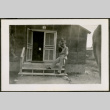
img
Men outside camp barrack (ddr-csujad-32-29)
Photograph of two Caucasian men standing on the stairs of barrack 45 at the Minidoka incarceration camp. Photo featured on page 14 of the Minidoka Incarceration Camp Photograph Album (csudh_ben_001). See this object in the California State Universities Japanese American Digitization project site: ben_01_001_015_047

img
Women outside camp barrack (ddr-csujad-32-28)
Photograph of two Caucasian women standing on the stairs of barrack 49 at the Minidoka incarceration camp. Photo featured on page 14 of the Minidoka Incarceration Camp Photograph Album (csudh_ben_001). See this object in the California State Universities Japanese American Digitization project site: ben_01_001_015_046

doc
Manzanar diary (ddr-csujad-34-1)
One diary written by Hiroshi Fukuwa, a Kibei Nisei of Los Angeles, California. His diary starts from his departing day from Los Angeles to move into the Manzanar incarceration camp as one of the first group of volunteer incacerees. He was transferred to the Gila River camp, Arizona, to join his brother's family, and segregated into …

doc
Manzanar diary (ddr-csujad-34-2)
English translation of a diary written by Hiroshi Fukuwa, a Kibei Nisei of Los Angeles, California. His diary starts from his departing day from Los Angeles to move into the Manzanar incarceration camp as one of the first group of volunteer incacerees. He was transferred to the Gila River camp in Arizona, to join his brother's …



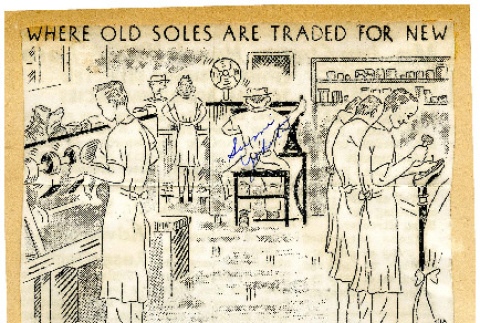









![Procurement and Shoe Rationing [Department] (ddr-csujad-26-106)](https://ddr.densho.org/media/cache/f3/2c/f32c2e41ac6313b3bdc118a6c63032ef.jpg)










